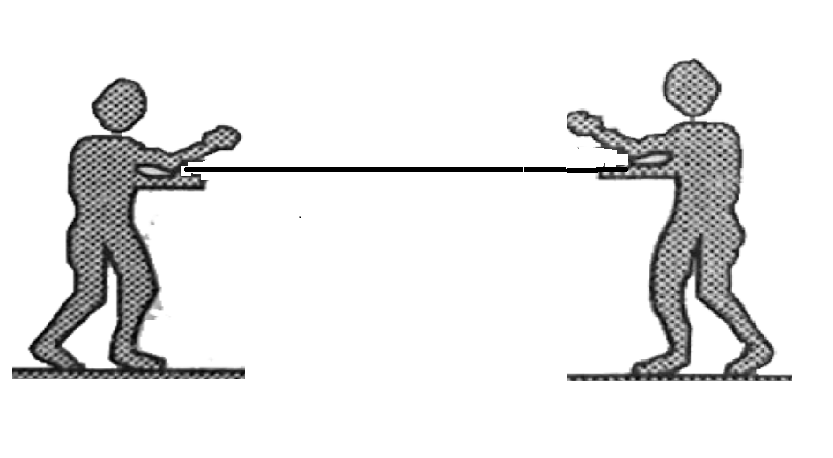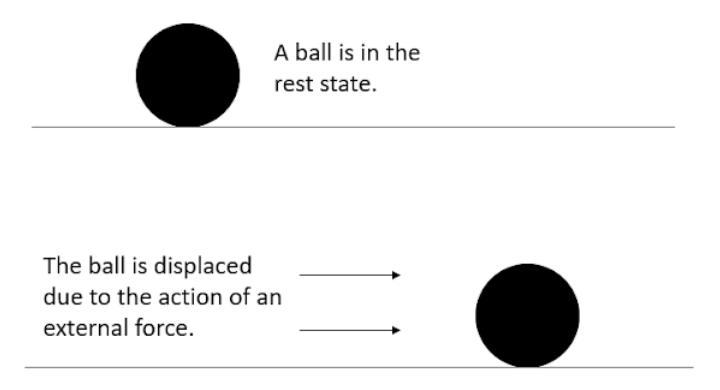
In a tug-of-war contest, two men pull on a horizontal rope from opposite sides. The winner will be the man who
A) exerts a greater force on the rope
B) exerts a greater force on the ground
C) exerts a force on the rope which is greater than the tension of the rope.
D) makes a smaller angle with the vertical
Answer
566.7k+ views
Hint: In the game of tug-of-war, both teams apply forces in terms of pulls on the rope. On the rope, two pulling forces act in opposite directions. The net force becomes the difference between the two forces (pulls) and the rope moves in the direction of the larger force (pull) because the third law states that for every action (force) in nature there will be an equal and opposite reaction.
Complete step by step answer:
According to Newton's third law of motion, during tug of war, the men will exert a greater force on the ground to get an opposite reaction force against the opposite team. The greater the force they exert on the ground, the more reaction force they can collect to pull the rope towards them.

For the ‘two men plus rope’ system, the external forces are those exerted by the ground on the men, which, by the third law of motion, are equal to the forces they exert on the ground. The system will move in the direction of the greater external force. In other words, if object P exerts a force on object Q, then object BQ will also exert an equal and opposite force on object P.
Hence the correct option is option (B).
Note:
Centuries ago, Newton’s laws of motions were considered revolutionary. There are totally three laws for motion framed by Newton.
The first law of motion:
Newton’s first law states that an object remains in the state of rest or of uniform motion unless or otherwise, an external force acts on it.

The second law of motion:
Newton’s second law states that the force acting upon a body is directly proportional to the acceleration and the mass of the body. Mathematically the law can be represented as
\[F = ma\]
Where $F$ is the force \[m\]is the mass of the body and \[a\]is the acceleration of the body.
Complete step by step answer:
According to Newton's third law of motion, during tug of war, the men will exert a greater force on the ground to get an opposite reaction force against the opposite team. The greater the force they exert on the ground, the more reaction force they can collect to pull the rope towards them.

For the ‘two men plus rope’ system, the external forces are those exerted by the ground on the men, which, by the third law of motion, are equal to the forces they exert on the ground. The system will move in the direction of the greater external force. In other words, if object P exerts a force on object Q, then object BQ will also exert an equal and opposite force on object P.
Hence the correct option is option (B).
Note:
Centuries ago, Newton’s laws of motions were considered revolutionary. There are totally three laws for motion framed by Newton.
The first law of motion:
Newton’s first law states that an object remains in the state of rest or of uniform motion unless or otherwise, an external force acts on it.

The second law of motion:
Newton’s second law states that the force acting upon a body is directly proportional to the acceleration and the mass of the body. Mathematically the law can be represented as
\[F = ma\]
Where $F$ is the force \[m\]is the mass of the body and \[a\]is the acceleration of the body.
Recently Updated Pages
Master Class 11 Economics: Engaging Questions & Answers for Success

Master Class 11 English: Engaging Questions & Answers for Success

Master Class 11 Social Science: Engaging Questions & Answers for Success

Master Class 11 Biology: Engaging Questions & Answers for Success

Class 11 Question and Answer - Your Ultimate Solutions Guide

Master Class 11 Business Studies: Engaging Questions & Answers for Success

Trending doubts
What is meant by exothermic and endothermic reactions class 11 chemistry CBSE

10 examples of friction in our daily life

One Metric ton is equal to kg A 10000 B 1000 C 100 class 11 physics CBSE

Difference Between Prokaryotic Cells and Eukaryotic Cells

What are Quantum numbers Explain the quantum number class 11 chemistry CBSE

1 Quintal is equal to a 110 kg b 10 kg c 100kg d 1000 class 11 physics CBSE




